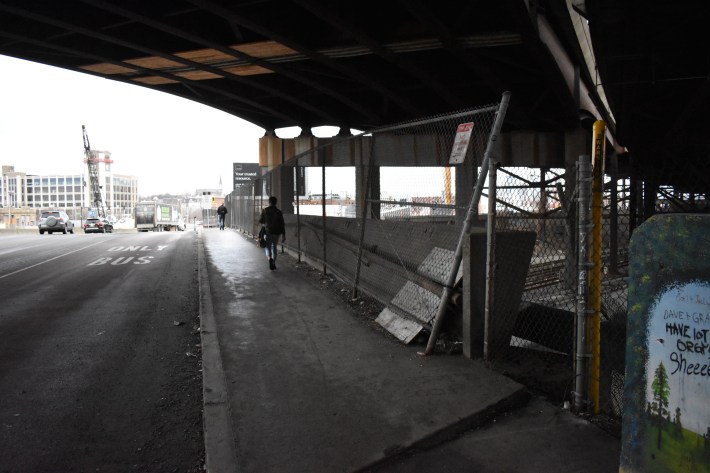For thousands of Orange Line riders in East Somerville, the daily walk to and from the T station at Sullivan Square requires negotiating a dark, trash-strewn sidewalk on Maffa Way, one of only two city streets that cross both the Orange Line tracks and the Interstate 93 viaduct.
It's a dismal gateway for transit riders in the neighborhood, with clouds of exhaust and roaring, high-speed traffic coming off the I-93 off-ramp.
But according to MassDOT, the twin state-owned bridges that span the Orange Line and Pan Am railroad tracks (carrying Mystic Avenue to the north, and Maffa Way to the south) are due for a replacement, and the proposed project could give transit riders, bicyclists, and pedestrians a much more attractive route between Somerville and Sullivan Square.

According to preliminary design documents from MassDOT, the new Maffa Way bridge would feature a slightly wider sidewalk (although its western end will remain obstructed by a large abutment for the I-93 viaduct). MassDOT also proposes to build a new two-way, physically separated bike path that would extend from Mount Pleasant Street on the Somerville/Boston city line to the Sullivan Square MBTA station. At its western end, that bike path would connect to existing painted bike lanes on Broadway in Somerville.
On Mystic Avenue, where almost half of the width of the existing bridge is blocked off by jersey barriers, MassDOT's early plans suggest that their replacement bridge might be slightly wider, to accommodate four lanes of motor vehicle traffic plus a 12-foot-wide sidewalk on the north side of the bridge.
That wide sidewalk could function as a shared-use path for bikes and pedestrians to share, and connect on its western end to the existing pathway along Grand Union Boulevard to the Assembly Orange Line station (it's unclear how, or whether, that path would connect to the Sullivan Square station).
"MassDOT reached out many months ago and our team was able to sit down at the right time and say to them, ‘Here is the framework for Somerville’s ADA transition plan, our emerging bike and bus network plans, the Mystic-Charles connector vision, and all of these regional greenway links and on-street bikeways, so work with us and all of our stakeholders to turn some of this highway infrastructure into better people infrastructure,’” said Brad Rawson, Somerville's Director Transportation & Infrastructure, in a phone conversation with StreetsblogMASS.
For people in cars, the Mystic Avenue bridge also feeds directly into what Somerville advocates have named the "corridor of death." For a driver speeding at 60 mph, this bridge is about 30 seconds away from the crosswalk where a hit-and-run driver struck and killed Cheryl Pauline Richards in 2019.
Ellin Reisner, East Somerville resident and advocate with the Somerville Transportation Equity Partnership (STEP), was surprised to learn about the project two weeks ago, but hopeful for the potential benefits that the project could deliver to her neighborhood.
"Putting in a protected bike lane would be a great idea and there’s certainly enough room there. There are a lot of crazy drivers that come down into that intersection," Reisner told StreetsblogMASS.
Her chief concern involved how the project might affect pedestrian access to the Orange Line during construction.
"If for some reason they closed these bridges, the only access point would be through Washington Street, which is a longer route and very inconvenient for people coming from East Somerville," Reisener told StreetsblogMASS.
Reisener and STEP have advocated in the past for a new pedestrian-only entrance to the Sullivan Square station from Perkins Street in East Somerville, with a short bridge over the inbound Orange Line tracks.
"It would be very convenient and keep people away from the busiest streets," she said.

Reisener also wants MassDOT to take the opportunity to improve lighting conditions under the I-93 viaduct.
"Aside from the fact that it’s incredibly dangerous, being next to the highway with all the air pollution, it’s just not an attractive place to be. It’s very dark under there in the winter and at night. And it feels very unsafe because it’s so dark… more than 10 years ago, we (at STEP) had a huge meeting to try and get MassDOT to do something about it, and they put in some new lighting, but it wasn’t sufficient."
MassDOT will host an online hearing on the bridge replacement project on Wednesday at 6 p.m. Register here.






